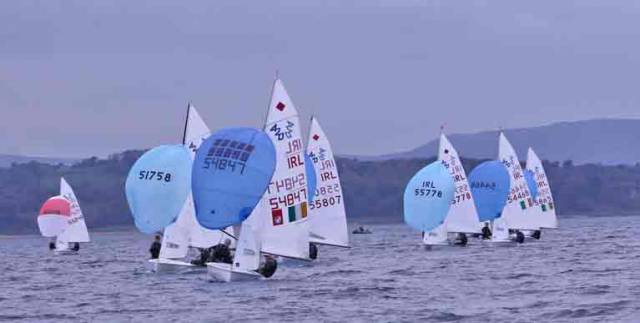Its full title is the Irish Sailing Association Youth Pathway Nationals and Optimist Trials. It is a designation with a great air of seriousness about it, contrasting markedly with current public debate about providing more fun sailing, while making regattas as much about sport and enjoyment afloat and ashore as they are about winning.
Yet from time to time, sailing does have to be serious – deadly serious – if we’re going to have any more significant international medals such as those won at the Olympics by Annalise Murphy, at the Laser Radials Worlds by Ewan McMahon,, and at the ISAF Youth Worlds by Doug Elmes and Colin O’Sullivan. The way those great achievements - hard won through a very serious training and participation programme - were able to immediately lift the public mood with their clearcut international success deserves full recognition. W M Nixon tries to put it into perspective for those whose own sailing does not aspire to the giddy international heights.
When you look at that title of “Youth Pathway Nationals and Optimist Trials”, you wonder that as many as 190 boats in six different classes have turned up at Ballyholme for the four days of racing. For there’d been a certain collective madness beforehand, with some folk talking of beyond 200 or even up to 250 boats. But that could be put down to an excess of exuberance following the impressive turnout of 125 Lasers for the Munster at Baltimore.
 On a tight spinnaker reach in Ballyholme Bay, McDowell and Gallagher narrowly lead the 420s from Heather Spain and iseult Kneafsey of the National, with Lucy Kane and Grace Jennings (East Antrim) next in line. Photo: Mark Mackey
On a tight spinnaker reach in Ballyholme Bay, McDowell and Gallagher narrowly lead the 420s from Heather Spain and iseult Kneafsey of the National, with Lucy Kane and Grace Jennings (East Antrim) next in line. Photo: Mark Mackey
For that was - for many - a fun event in a fun place, with a fun fleet except for maybe the top ten - and even they were frequently seen to laugh. And for sure, there are kids who are having a ball at Ballyholme right now. But for just this one long weekend of the year, there are serious moves being made which will decide the development of junior sailing at the top level in the year ahead, and in many of the years beyond that. We should be worried if it weren’t so brutally focused, rather than being unduly concerned about junior sailing becoming too serious.
That said, the seriousness produces its lighter moments, though you could sympathise with the Topper person who noted that there are five Topper places up for grabs for admission to the Topper Pathway Scheme, yet there are 32 Toppers (39 including the 4.2s) racing their little hearts out at Ballyholme. “What are we going to say?” asked this conscience of the Topper class, “What are we going to say to the young skippers who come 6th, 7th and 8th.....?”
Then there was the Optimist dad who arrived into the Race Office letting the world know that his family’s budget for the event was already shot to ribbons. Heaven only knows what the accommodation pressure would have been like if the more optimistically anticipated fleet of 250 boats with all classes had all turned up. For as it is, accommodation pressures have resulted in people being forced to rent houses for the week – for there’s no way you can get a rental starting on a Wednesday night – and deciding that the sensible thing is to come for a week’s holiday for the whole family. Inevitably, it means lots of money running out the door before the one or two family members who are actually racing start their proper sailing.
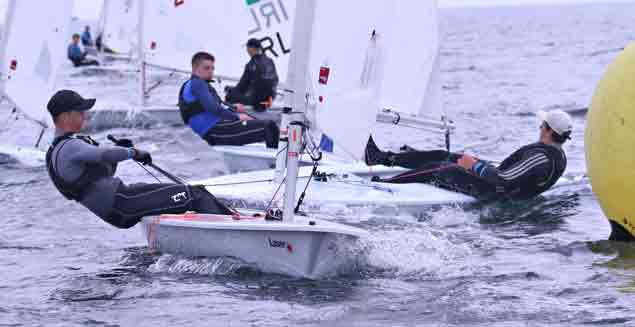 After two days Ewan MacMahon of Howth has the overall lead in the Laser Radials. Photo Mark Mackey
After two days Ewan MacMahon of Howth has the overall lead in the Laser Radials. Photo Mark Mackey
So anyway this Opty dad is telling anyone who is listening that the budget is already shot with the family spending a whole week in a house in a village he’d never heard of before. But now, worse still, somebody has just told him that his daughter is seen as one of the rising stars of the class, and they wouldn’t be surprised, once this weekend’s racing is finished, to see her name down as a potential member for the Irish squad at the Optimist Worlds 2017 at the Royal Varuna Yacht Club in Thailand in July.
“And do you know what that means?” he demands. “It means that if we accept that offer of a place at the Worlds, within a week we have to divvy up €2,000 for the International Optimist Dinghy Association of Ireland. I can tell you something” he continues, now in full flight, “if she’s anywhere within range of a place with only one or two races still to go, we’ll be seriously thinking of feeding her a dodgy chicken sandwich.....”
Such are the joys of being an Opty dad. And it was something to contemplate along with the fondest recollections at an event on Thursday night in my own home club of Howth, when friends from times past – some of them friends from very long times past – joined with the great and the good including ISA President Jack Roy and his wife Rosemary, and HYC Commodore Joe McPeake – together with a whole raft of former HYC Commodores – to celebrate the award by World Sailing (formerly ISAF) of a Gold Medal to Howth’s own Helen-Mary Wilkes for her decades of service to the International Optimist Dinghy Association worldwide.
 At the conferring of Honorary Membership of Howth Yacht Club on Helen-Mary Wilkes in celebration of her Gold Medal from World Sailing are (left to right) Jack Roy (President, Irish Sailing Association), Joe McPeake (Commodore Howth YC, who is holding a copy of Robert Wilkes’ History of the International Optimist Class,) Helen-Mary Wilkes, and Robert Wilkes. Photo: John Deane
At the conferring of Honorary Membership of Howth Yacht Club on Helen-Mary Wilkes in celebration of her Gold Medal from World Sailing are (left to right) Jack Roy (President, Irish Sailing Association), Joe McPeake (Commodore Howth YC, who is holding a copy of Robert Wilkes’ History of the International Optimist Class,) Helen-Mary Wilkes, and Robert Wilkes. Photo: John Deane
Her international career started when it was noted that she was the key player as Secretary of the Organising Committee when Howth ran the Optimist Worlds in 1981. After that, Helen-Mary’s international service was of such quality and duration that her most recent years with the IODA have been as President of Honour. For, in the many years she was actually running it all on a day-to-day basis with the backroom support of her husband Robert, they saw an increase of 78% in international membership of the world association to bring the total to 87 countries, and 57 of those countries regularly took part in international championships, while boat numbers increased stratospherically.
It was by no means an easy ride, for with main builders in several countries and different continents, the Optimists were by no means totally One-Design. But fortunately Helen-Mary Wilkes had the very man in Ireland with the skill, patience and diplomacy to sort this out - David Harte of Schull, at that time a Howth resident. As an Optimist builder himself, “Harty” knew everything about these very important little boats, and between 1995 and 1997 he was on an almost continuous worldwide mission to persuade the eight main builders to standardise the class to the highest One-Design requirements, an objective in which he succeeded.
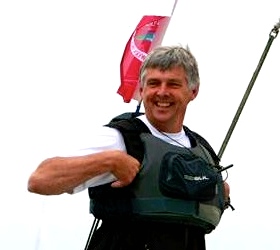 David Harte of Schull, who in 1995 -1997 was instrumental in ensuring that the eight production builders worldwide of the International Optimist Dinghy were producing a truly One-Design boat.
David Harte of Schull, who in 1995 -1997 was instrumental in ensuring that the eight production builders worldwide of the International Optimist Dinghy were producing a truly One-Design boat.
David Harte being one of these people who seems ageless, it takes a bit of an effort to realize that he was doing this all of twenty years ago. But the result has been a much more total global acceptance of the Optimist. And in speaking to Thursday night’s gathering, Helen-Mary and Robert Wilkes addressed people’s concerns that the current event in Ballyholme, and other major Optimist championships in Ireland, are becoming too serious for the good of the young sailors.
“We’re every bit as interested in the kids who are into Optimists just for club racing and local sailing as we are for the high flyers. Over Easter, there are five major Optimist regattas under way at different venues in Europe. In all, more then 4,500 Optimists are sailing at every possible level of competition in these events. Yet at none of those regattas is selection for special strands of training under way. Ultimately, it is all about sailing for sailing’s sake. It only happens to be the case that it’s in Ireland the Easter Regatta is also being used for the trials. Inevitably, there’s criticism that the kids are being put under too much pressure here. But as a matter of policy, the International Optimist Dinghy Association is as interested in friendly local racing as it is in international competition”.
 “Get ’em up and move ’em out....” Optimists and Lasers swing into the launch sequence at Ballyholme. Photo: Pierce Purcell Jnr
“Get ’em up and move ’em out....” Optimists and Lasers swing into the launch sequence at Ballyholme. Photo: Pierce Purcell Jnr
Meanwhile last night up at Ballyholme they were able to post two days of good racing results in westerly winds for the Laser Radials, 420s and Optimists, and one day of racing for the Toppers, Laser 4.7s and Topper 4.2s.
LASER RADIALS
After a 7th, 4th and 6th on Thursday, when Aaron Rogers of Rush SC was the overnight leader, Ewan MacMahon of Howth came back like a rocket yesterday and posted 1,1, and 2nd to leave him leadng on 14pts to the 20 of Henry Higgins of the Royal St George in second (4,(26) 2,4,2,8), with Johnny Durcan of Royal Cork finishing strongly with a bullet in yesterday’s concluding race for a scoreline of 2,8,10, (42 BFD) 3, 1 and a points total of 24. Rush SC pair of Conor Quinn and Aaron Rogers are next on 27 and 28 in a fleet of 43.
420
Geoff Power and James McCann of Dunmore East have recovered from an OCS yesterday to take over the lead in a healthy fleet of 16, they have totalled 6 points with a used scoreline of 2,1,1,1,1, with Gemma McDowell and Emma Gallagher of Malahide taking one of the two spare wins after the Power display of, well, power, the Malahide crew now lie second on 12 points, just one point ahead of the other race winners, Kate Lyttle and Niamh Henry of Royal St George.
OPTIMISTS
Justin Lucas (13) of Tralee and Royal Cork had been hotly tipped as the favourite for the Optimists, and he has certainly lived up to the billing with a scoreline of 1,1,(12),11,4,5,1 after two days of racing in a 62-strong fleet. There has been some post-racing re-arrangement of results with protest outcomes, but Lucas is well clear of Royal Cork’s Michael Carroll with 23 points to the 37 of Carroll in second, while James Dwyer Matthews (Cork & Kinsale) is tied on 40 with the leading junior Luke Turvey (Howth and National,) who goes to fourth on the higher discard. Leah Ricard of the National is top girl at 9th overall.
LASER 4.7
The National YC’s Clare Gorman leads after the first day of racing for the 4.7s, with a scoreline of 4,2, and 1 to give 7 pts against the 9 of Royal St George’s Jack Fahey in second, third slot being held by David Carroll of Kinsale & Crosshaven while Tom Higgins of RStGYC and Eva MacMahon of Howth tie on 16, but Higgins takes 4th on the discard in a fleet of 33.
TOPPER
Rob Keal of Royal Cork had a good first day of it yesterday to lodge two firsts and a fourth, giving him 6pts against the 11 of second placed Kate Fahy (RStGYC & Lough Derg) while East Down’s Sarah Jennings’ 13pts keeps her in third ahead of Royal Cork’s Conor Horgan on fourth in a fleet of 32.
TOPPER 4.2
Lewis Thompson of Ballyholme and Donaghadee has had three straight firsts to the three seconds of Ballyholme’s Hannah Dadley-Young, third overall is Donaghadee/Ballyholme’s Joshua McGregor with two hirds and a fourth while Adam Irvin of the Irish National Sailing School is fourth on 4,5,4.
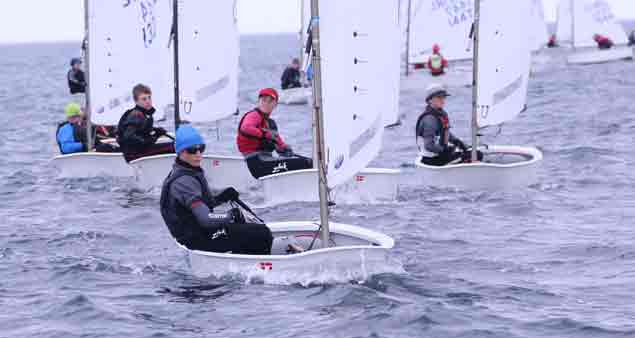 Justin Lucas of Tralee Bay is leading the 62-strong Optimist fleet. Photo: Mark Mackey
Justin Lucas of Tralee Bay is leading the 62-strong Optimist fleet. Photo: Mark Mackey
It is interesting to contemplate all this highly-regulated contemporary modern sailing on Belfast Lough, for it was far from Lasers and 420s and four days of intensive racing from committee boat starts that we were reared when we spent our first years afloat in and around Ballyholme Bay.
In those days, proper junior training and a structured junior racing programme weren’t so much in their infancy as barely a gleam in anyone’s eye. At a certain age – before any of us was even into our teens – we were given a new 14ft clinker sailing dinghy of the Ballyholme Insect Class, and told to get on with it on the assumption that, having sailed with adults in keelboats, we’d know how it was done.
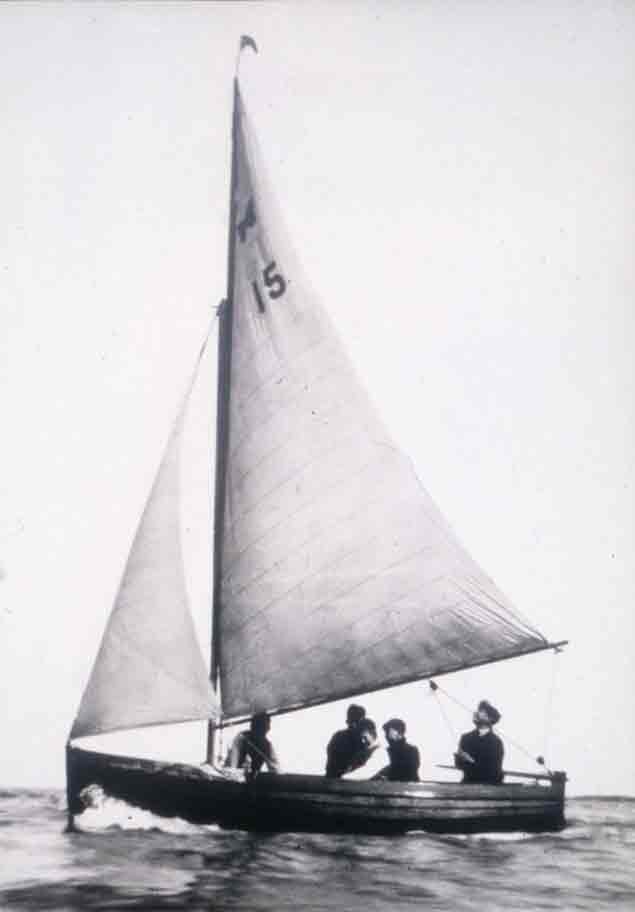 Steep learning curve. We weren’t even into our teens when we were presented with a 14ft Ballyholme Insect Class, and told to get on with it. Photo: W M Nixon
Steep learning curve. We weren’t even into our teens when we were presented with a 14ft Ballyholme Insect Class, and told to get on with it. Photo: W M Nixon
With a massive lack of imagination, we called her Grasshopper. In truth, Rockhopper would have been more on target. The distinctly exposed Ballyholme Bay is sheltered to the northeast, ’tis said, by Ailsa Craig, which is 40 miles away. Admittedly the bay has a decidedly featureless shoreline at low water, which limits sailing options even if you aren’t hampered by strong onshore winds. But when the tide is well in, all sorts of little islands and channels are created, and we learnt our sailing threading our way through this miniature maze of skerries.
 Ballyholme Bay at Low Water has a rather featureless shoreline....
Ballyholme Bay at Low Water has a rather featureless shoreline....
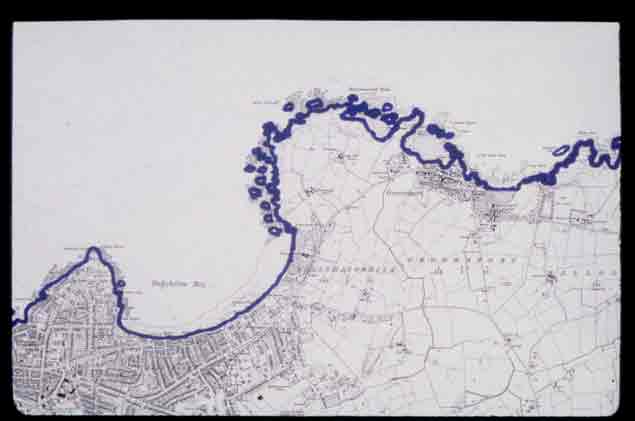 ....but at High Water it becomes a much more interesting place, with all sorts of islands and channels.........
....but at High Water it becomes a much more interesting place, with all sorts of islands and channels.........
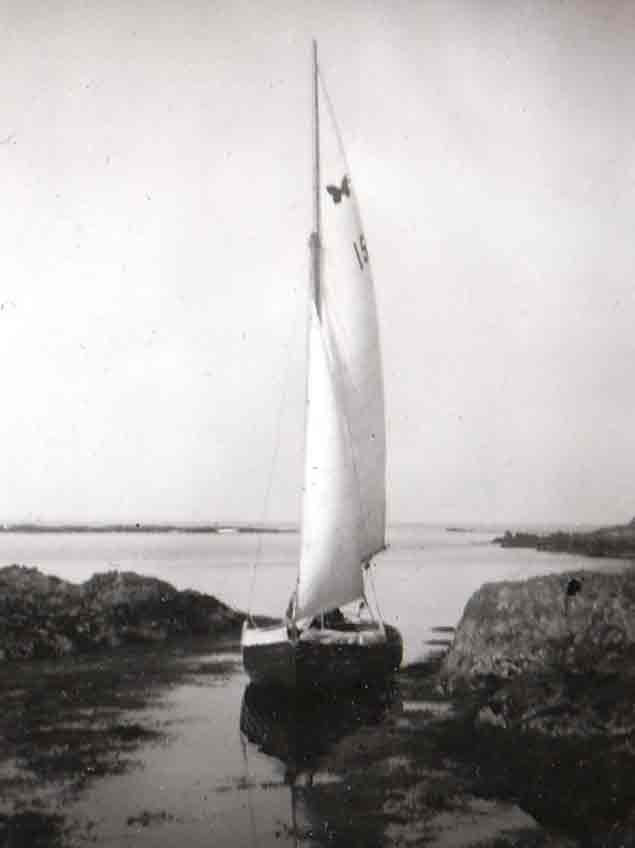 ......through which a sailing dinghy with centreplate half-raised can thread her way. Photo: W M Nixon
......through which a sailing dinghy with centreplate half-raised can thread her way. Photo: W M Nixon
There was of course no such thing as an accompanying rescue boat, but from time to time we sailed in consort with a friend whose boat was a smaller sister, a 12ft–clinker dinghy, but made more exotic with a little bowsprit.
Safety rules were few. We were expected to wear kapok lifejackets when actually sailing, but not otherwise, and they’d immediately be used as fenders if we came alongside rocks or small jetties. As for sailing limits, we were supposed to stay in Ballyholme Bay south of a line from Luke’s Point on the west side over to a rock called Jenny’s Isle off Ballymacormick Point to the northeast. However, at high water you could sail with the centreplate half up inside Jenny’s Isle and the tidal islets beyond it, so you could keep going east, while staying within that outer limit line, until you’d gone clean round the world.
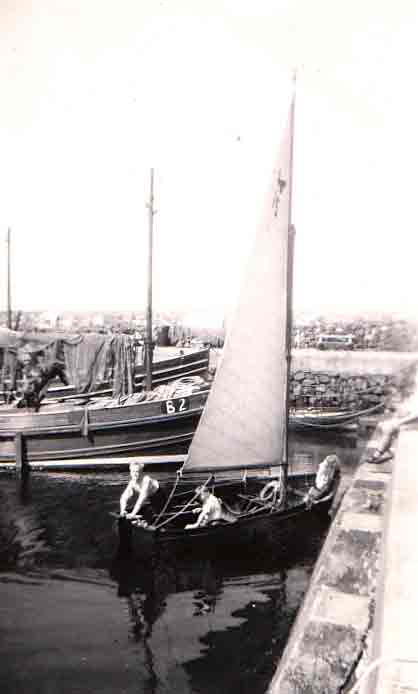 Groomsport, a little fishing harbour which was our first “foreign port.” It is less than two miles from the anchorage at Ballyholme Bay Photo: W M Nixon
Groomsport, a little fishing harbour which was our first “foreign port.” It is less than two miles from the anchorage at Ballyholme Bay Photo: W M Nixon
But there wasn’t that much mischief in us, so it was quite a day when official permission was given to sail all the way to the nearby fishing harbour of Groomsport, our very first Foreign Port of Call. And after that, the south shore of Belfast Lough from Orlock Point to Grey Point was our cruising paradise, and we’d disappear off for the entire day with a basic lunchbox and the hope of augmenting it with mackerel.
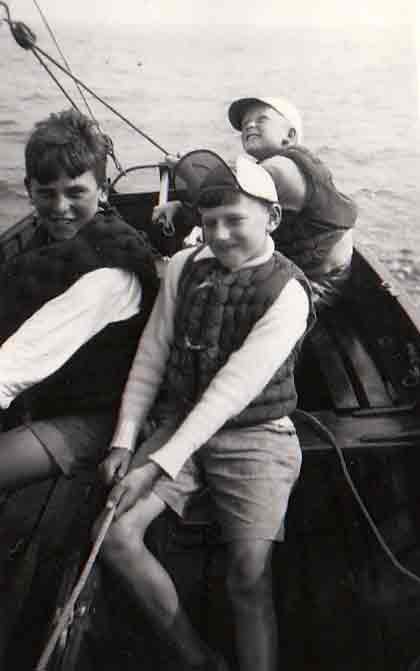 Off for a days cruising, with a lightly packed lunchbox and a couple of mackerel lines to augment the meal. Photo: W M Nixo
Off for a days cruising, with a lightly packed lunchbox and a couple of mackerel lines to augment the meal. Photo: W M Nixo
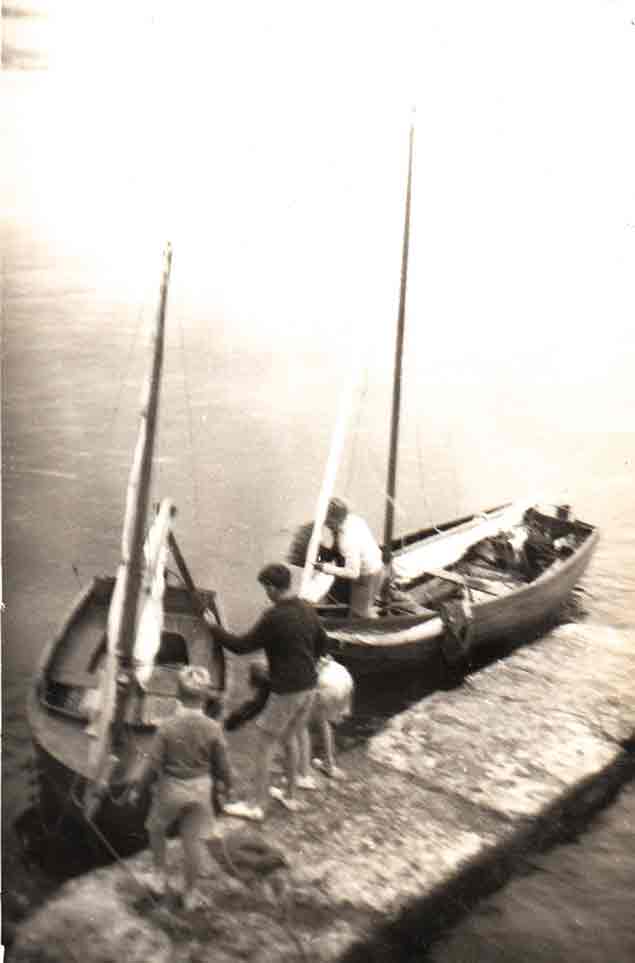 Cruise in company. The fleet gathers at Swinley Bay three miles west of Ballyholme, and lifejackets soon become fenders. Photo W M Nixon
Cruise in company. The fleet gathers at Swinley Bay three miles west of Ballyholme, and lifejackets soon become fenders. Photo W M Nixon
If the wind fell light in the evening, we could row home, and over the years nobody gave our daylong absences any thought. There were some close calls, but we never actually capsized the boat. Which was just as well, for if you capsized an Insect, she stayed capsized, and you were barred for a week from Ballyholme Yacht Club for what was deemed reckless and unseamanlike behavior.
That was how you learned to sail back in the day. Eventually it was reckoned we knew enough to be reasonably harmless to others if we went racing with what was then Ballyholme’s only dinghy class. A long way indeed from the hotshot dinghies of today, and their accompanying coaches in their RIBs.



























